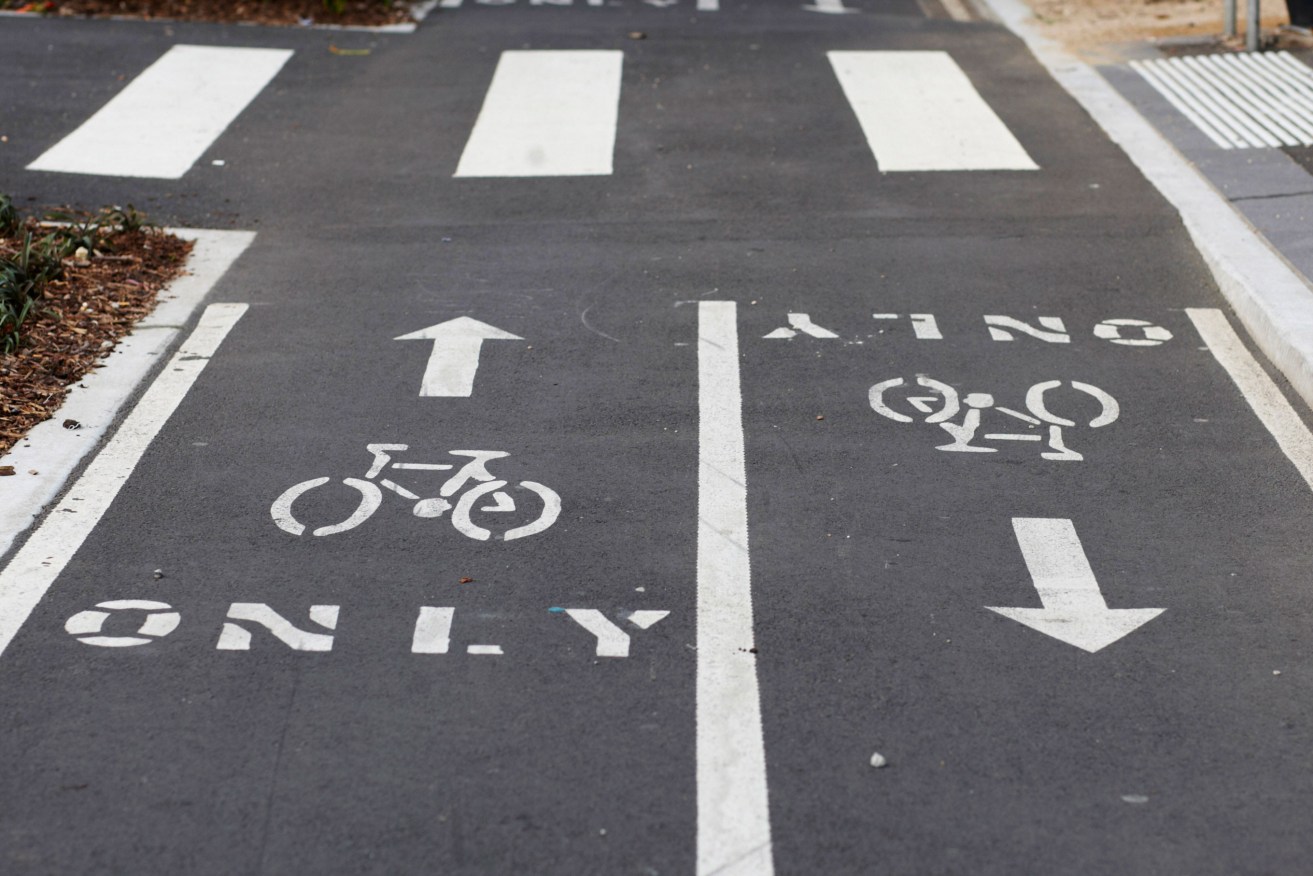What can I do now? Questions answered on new bike laws
No sooner had South Australia’s new cycling regulations launched, confusion reined. The Law Society SA is here to help us get through the maze of new road rules.


Too close? Too far away? Who has right of way? Where do I stop? When can I go?
The questions from cyclists, pedestrians and motorist triggered by South Australia’s new bike laws has become a loud din.
There have been some fairly inventive suggestions about how to abide by the new laws since they came into effect on October 25, but the Law Society SA has provided InDaily with answers to 13 of the most popular questions.
“While the intention of the laws is to protect the safety of cyclists, there is some uncertainty about how the laws will be enforced and the impact of the laws on pedestrians and motorists,” Law Society president Rocco Perrotta said.
In particular, Perrotta said there was some confusion over how pedestrians injured by cyclists could pursue compensation.
“Because cyclists don’t need to be insured, an injured person’s entitlement to claim damages will very much depend on the individual circumstances of the case.
“Merely proving fault might not be enough.”
Q&A
- Can you drive across any dividing lane to keep the required distance between your vehicle and the cyclist?
The new laws allow drivers to move across a dividing lane, even a double white line, in order to keep the required distance from a cyclist, if it is safe to do so. If it is unsafe to cross lanes, the driver of the motor vehicle must wait behind the cyclist until the motorist can safely pass the cyclist while maintaining the required distance.
- Would you be covered by your car insurance policy if the car you were driving hit a car coming the other way?
South Australia has a compulsory motor vehicle insurance scheme for personal injury resulting from motor vehicle accidents. It is a fault-based scheme except in the case of catastrophically injured motorists. Therefore, if a motorist moved across to the opposite lane so as to keep the required distance from a cyclist, but hit an oncoming car and was injured, the motorist would have to prove that he or she was not at fault in order to claim personal injury compensation. Given that the laws only allow motorists to move across to another lane when they have a clear view of oncoming traffic and when it is safe to do so, this may be difficult. For a property damage claim, you would probably need to rely on your comprehensive or third party insurance policy through your private insurer and it is recommended that you seek advice about what you are covered for.
- Is passing a cyclist the only reason why you can cross over a double white line?
The only other reason a motorist can cross a double white line is to avoid an obstruction on the road. An obstruction is defined in the Australian Road Rules as “a traffic hazard, but does not include a vehicle only because the vehicle is stopped in traffic or is travelling more slowly than other vehicles”.
- Are pedestrians allowed to walk along bike paths?
No. Pedestrians must not be on a bike path or part of a footpath designated for cycling, except to cross the path.
- Are these laws consistent with interstate practices?
South Australia is the first Australian state or territory to have the “one metre rule” enshrined in law. Queensland is currently undergoing a two-year trial of the law, and the ACT began such a trial on November 1. Other states such as WA and Victoria have the “one-metre rule” written into their road safety code of conduct, but these are recommendations rather than legally enforceable rules.
- Does the cyclist need to keep as far to the left as possible?
Yes. Cyclists are required by law to keep close as practicable to the left side of the road, except when making a right turn, overtaking, or where the road is divided into lanes.
- If there is a bike lane and the cyclist is within the bike lane does a car that is in the adjoining lane still need to observe the one-metre rule?
Yes. Even when a cyclist in in a bike lane, a driver of a car must keep the required one metre away from the cyclist in 60km and below zones, and 1.5m away in above 60km zones.
- Can pedestrians injured by cyclists claim for damages?
Any claim for damages would depend entirely on the circumstances. The injured person would have to prove negligence on the part of the cyclist.
In the case of shared use footpaths, all users have a duty to keep a proper look out and walk or ride to the conditions. It appears however that under the new regulations, cyclists can apply the same rules as if riding on a road. However, a cyclist should not expect that riding at the same speed as that applicable to roads would save the cyclist from being found negligent.
An injured pedestrian could take action against the offending cyclist, but if the cyclist is not insured and impecunious, the likelihood of receiving compensation is negligible.
There is no law requiring cyclists or pedestrians to have insurance to cover their liability to others if they are found to be negligent on a road or footpath. That said, most home and contents insurance policies have legal liability which covers negligent use of a bicycle causing injury to others.
Cyclists may also be able to obtain legal liability insurance through bike club membership. It would be prudent for cyclists to take appropriate advice on available insurance cover for any liability which might arise as the result of any collision, either with a car or pedestrian on a road or footpath.
- If a pedestrian injured by a cyclist cannot sue the cyclist, can he or she sue the council?
A pedestrian injured by a cyclist on a footpath would be entitled to make a claim against the cyclist in the same way as if it had occurred on the roadway. The injured pedestrian could not make out a claim against the council unless it was established that that the accident was due to council’s negligence. The pedestrian or cyclist would need to establish that the negligence on the part of the council caused or contributed to the collision.
- What are Regulations?
Regulations are a form of subordinate legislation that are made under the authority of an existing Act of Parliament. Regulations usually supplement existing laws with greater detail. For example, the cost of traffic fines would usually be set via regulation, as they don’t alter the framework of the statute. Regulations negate the need to pass a new law for relatively minor, superficial changes to statues.
However, some regulations can be quite substantial so long as they sit within the statutory framework of the Act. It can be argued that the new bike regulations significantly change the rules for motorists and cyclists on our roads and footpaths.
- Why introduce laws via Regulation?
It is considerably quicker to introduce rules via regulation, rather than legislation. Regulations can be introduced by government without having to go through the more detailed process of enacting legislation. It is a more efficient and flexible way to introduce or change certain laws, but there is a limit to what can be introduced as regulation. It is a fundamental democratic principle that substantial changes to law are comprehensively debated.
- Can Regulations be rejected?
Yes. While regulations can be introduced without debate, a Member of Parliament can raise a disallowance motion within 14 Parliamentary sitting days of the regulations being laid before both Houses of Parliament. Regulations can be disallowed after they come into effect, provided a motion is put forward within 14 sitting days.
By convention, a motion to disallow would normally be put forward by a Member of the Upper House. The Legislative Review Committee can inquire into regulations and make a recommendation to disallow them.
Importantly, the regulations must be disallowed in total – you cannot disallow a part of the regulations.
Regulations can also be challenged in court on various grounds, including whether they are inconsistent with the Act of Parliament under which they are made or whether they offend the common law.
- What is the speed limit for cyclists riding on footpaths?
The Australian Road Rules and Road Traffic (Road Rules—Ancillary and Miscellaneous Provisions) Variation Regulations 2014 are silent on the matter of speed limits for cyclists on footpaths. Rule 20 of the Australian Road Rules states drivers must obey speed limits on roads and “road related areas”. A footpath is a “road related area”. While there does not seem to be a definitive answer to this question, there does not appear to be any rule prescribing a footpath speed limit that is lower than speed limit of the adjoining road. The law does state that a cyclist on a footpath or shared path must “keep to the left of the footpath or shared path unless it is impracticable to do so; and give way to any pedestrian on the footpath or shared path”.
Happy travelling.






